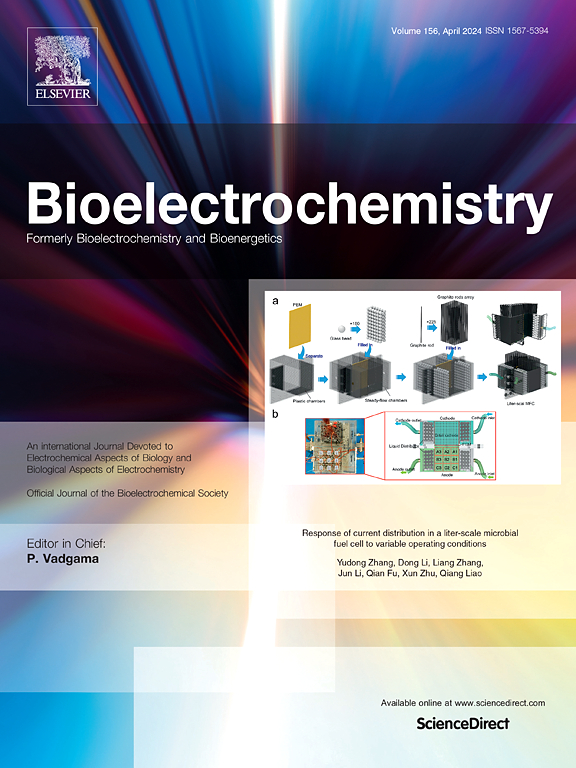A sensitive electrochemiluminescence immunosensor for CEA detection based on the ECL-RET between zinc-based metal–organic frameworks and ZiF-8@PDA
IF 4.8
2区 化学
Q1 BIOCHEMISTRY & MOLECULAR BIOLOGY
引用次数: 0
Abstract
In this study, we developed a new system that using zinc-based metal–organic frameworks NH2-Zn-PTC as the donor and ZiF-8@PDA as the acceptor to achieve highly sensitive detection of carcinoembryonic antigen (CEA), using the fundamentals of electrochemiluminescence resonance energy transfer (ECL-RET). Firstly, the aggregation-induced quenching effect (ACQ) was eliminated by the coordination of PTC in MOF and the ECL signal was improved. Secondly, the ECL signal was further amplified by using Au NPs and amino groups as co-reaction promoters to generate more SO4.−. In addition, the introduction of ZiF-8@PDA as an acceptor and NH2-Zn-PTC as a donor took advantage of the feature of partial overlap of the UV–vis absorption spectrum and ECL emission spectra between the two, thereby effectively initiating the ECL-RET behavior, which improved the detection sensitivity of the sensor. The prepared immunosensor showed good linearity in the concentration range of 10−4 to 80 ng/mL with a detection limit of 18.20 fg/mL. This makes it promising for clinical testing of tumor markers.

一种基于锌基金属有机框架和 ZiF-8@PDA 之间的 ECL-RET 的灵敏 CEA 检测电化学发光免疫传感器。
本研究以锌基金属有机框架 NH2-Zn-PTC 为供体,ZiF-8@PDA 为受体,利用电化学发光共振能量转移(ECL-RET)的基本原理开发了一种新的系统,实现了对癌胚抗原(CEA)的高灵敏度检测。首先,PTC 在 MOF 中的配位消除了聚集诱导淬灭效应(ACQ),提高了 ECL 信号。其次,利用 Au NPs 和氨基作为共反应促进剂生成更多的 SO4.-,进一步放大了 ECL 信号。此外,引入 ZiF-8@PDA 作为受体,NH2-Zn-PTC 作为供体,利用了两者的紫外可见吸收光谱和 ECL 发射光谱部分重叠的特点,从而有效地启动了 ECL-RET 行为,提高了传感器的检测灵敏度。制备的免疫传感器在 10-4 至 80 ng/mL 的浓度范围内表现出良好的线性关系,检测限为 18.20 fg/mL。这使其有望用于肿瘤标志物的临床检测。
本文章由计算机程序翻译,如有差异,请以英文原文为准。
求助全文
约1分钟内获得全文
求助全文
来源期刊

Bioelectrochemistry
生物-电化学
CiteScore
9.10
自引率
6.00%
发文量
238
审稿时长
38 days
期刊介绍:
An International Journal Devoted to Electrochemical Aspects of Biology and Biological Aspects of Electrochemistry
Bioelectrochemistry is an international journal devoted to electrochemical principles in biology and biological aspects of electrochemistry. It publishes experimental and theoretical papers dealing with the electrochemical aspects of:
• Electrified interfaces (electric double layers, adsorption, electron transfer, protein electrochemistry, basic principles of biosensors, biosensor interfaces and bio-nanosensor design and construction.
• Electric and magnetic field effects (field-dependent processes, field interactions with molecules, intramolecular field effects, sensory systems for electric and magnetic fields, molecular and cellular mechanisms)
• Bioenergetics and signal transduction (energy conversion, photosynthetic and visual membranes)
• Biomembranes and model membranes (thermodynamics and mechanics, membrane transport, electroporation, fusion and insertion)
• Electrochemical applications in medicine and biotechnology (drug delivery and gene transfer to cells and tissues, iontophoresis, skin electroporation, injury and repair).
• Organization and use of arrays in-vitro and in-vivo, including as part of feedback control.
• Electrochemical interrogation of biofilms as generated by microorganisms and tissue reaction associated with medical implants.
 求助内容:
求助内容: 应助结果提醒方式:
应助结果提醒方式:


